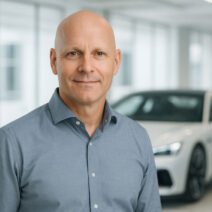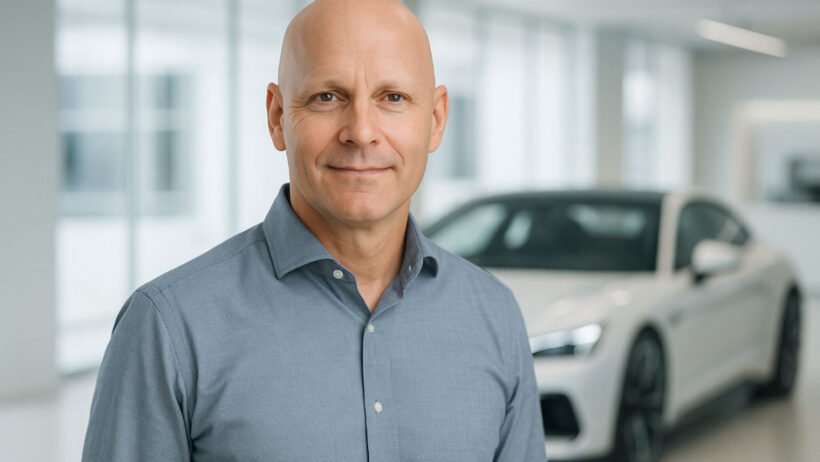Christian von Koenigsegg’s Net Worth: A $100 Million Success Story
Christian von Koenigsegg’s net worth stands at an impressive $100 million, a fortune built through decades of dedication to hypercar excellence. The Swedish entrepreneur transformed his childhood fascination with fast cars into Koenigsegg Automotive AB, now recognized as one of the world’s most exclusive automotive manufacturers.
Here’s what makes his story truly captivating: despite commanding a nine-figure fortune, this hypercar mogul chooses to drive a 1992 Mazda Miata worth roughly $12,000. It’s a choice that perfectly encapsulates his unconventional approach to both business and life.
Koenigsegg didn’t inherit his wealth or stumble into success. His path from trading frozen chicken in post-Soviet Estonia to crafting million-dollar hypercars represents entrepreneurial vision at its finest. Today, celebrities like Floyd Mayweather and Jay Leno count themselves among his clientele, yet the man behind these automotive masterpieces remains refreshingly grounded.
From Noble Heritage to Entrepreneurial Vision
Early Life and Family Background
Born July 2, 1972, in Stockholm, Christian Erland Harald von Koenigsegg carries a name that echoes through centuries of European history. His family lineage stretches back to 1171 CE, originating in Swabia within the Holy Roman Empire, where his ancestors served as knights.
The entrepreneurial spirit ran in the family. His father, Jesko von Koenigsegg, built his career as CEO of JK Energiteknik, while his mother, Brita Aasa, made her mark in fashion. This combination of business acumen and creative flair would later prove instrumental in Christian’s automotive ventures.
Everything changed when five-year-old Christian watched “The Pinchcliffe Grand Prix.” This Norwegian stop-motion masterpiece tells the story of a bicycle mechanic who builds his own racing car and defeats professional competitors. The film sparked something profound in the young boy’s imagination—a dream that would eventually reshape the hypercar industry.
First Business Ventures and Financial Foundation
Most teenagers dream of fast cars, but Koenigsegg was already building his business empire at 19. His import-export company might not have sounded glamorous—dealing in frozen chicken and misprinted plastic bags—but it proved remarkably profitable.
The timing was perfect. Estonia had just gained independence from the Soviet Union, creating demand for Western goods. Koenigsegg seized this opportunity, establishing trade relationships that generated substantial income. His willingness to tackle unglamorous work while others his age were still in school demonstrated the focus that would later drive his automotive success.
These early profits weren’t spent on typical teenage luxuries. Instead, Koenigsegg carefully saved every dollar, building the financial foundation that would soon support his automotive ambitions. By age 22, he had accumulated $200,000—enough to take the biggest gamble of his life.
Building the Koenigsegg Automotive Empire
The $200,000 Gamble That Started It All
August 12, 1994, marked the official birth of Koenigsegg Automotive. Christian was just 22 years old when he invested his entire $200,000 savings into what many considered an impossible dream: competing with Ferrari, Lamborghini, and McLaren.
The money disappeared faster than anyone anticipated. Within months, Koenigsegg faced a harsh reality—building cars requires far more capital than building import-export relationships. His father, Jesko, stepped in with a $300,000 loan, believing in his son’s vision despite the obvious risks.
That initial loan was just the beginning. Over the following years, Jesko would invest his entire life savings—approximately $2 million—into his son’s venture. “My father didn’t know it then, but he would over the next few years invest his life savings,” Christian later reflected. “Naturally my mother freaked out.” The family’s financial future now depended entirely on Christian’s ability to build cars that could compete with the world’s best.
From Prototype to Production Success
The first breakthrough came in 1996 when Koenigsegg’s team completed their initial running prototype. After two years of development, they had proven that a small Swedish company could actually build a functioning supercar. The prototype wasn’t just a rolling chassis—it was a complete, driveable vehicle that validated their entire approach.
1997 brought their boldest marketing move yet: showcasing their nearly production-ready supercar at the Cannes Film Festival. While established manufacturers spent millions on traditional advertising, Koenigsegg chose to make a statement among the world’s elite. The strategy worked, generating international attention and establishing the brand’s luxury credentials.
The CC8S finally reached customers in 2003, nearly a decade after the company’s founding. Those first six vehicles represented more than just sales—they proved that Koenigsegg Automotive could deliver on its promises. Each CC8S generated 655 horsepower and earned a Guinness World Record as the most powerful production car ever built.
Innovation and Patents: The Technical Mastermind
Christian von Koenigsegg holds over a dozen US patents, each representing breakthrough innovations in automotive technology. His Freevalve system eliminates traditional camshafts entirely, using compressed air and electronics to control valve timing with unprecedented precision. This technology allows engines to run more efficiently while reducing weight and complexity.
The direct drive transmission showcases another area where Koenigsegg’s thinking diverges from industry norms. Instead of traditional multi-gear systems, his approach provides seamless power delivery through innovative clutch arrangements. The result is acceleration that feels more like an electric vehicle than a conventional supercar.
His synchro helix door system has become a Koenigsegg signature, allowing doors to rotate upward and forward simultaneously. While visually striking, the system also serves practical purposes, requiring less clearance space than traditional scissor doors while maintaining the dramatic visual impact customers expect.
Koenigsegg’s philosophy drives every innovation: “I could have made my life easier. Half of the strangeness we have done would have been enough. But innovation, along with performance and function, is what drives me.” This commitment to pushing boundaries has resulted in vehicles that consistently break performance records while introducing technologies later adopted by larger manufacturers.
The Modest Millionaire: Christian von Koenigsegg’s Surprising Lifestyle
A $100 Million Man’s Daily Drivers
Walk into Christian von Koenigsegg’s garage, and you might be surprised by what you find. His daily driver isn’t a $3 million Jesko or even a $2.2 million Regera. Instead, he climbs behind the wheel of a 1992 Mazda MX-5 Miata—the same car he bought as a teenager and has repurchased “three times over the years.”
The Miata holds special meaning beyond nostalgia. Koenigsegg genuinely believes in its engineering excellence, particularly praising its transmission as “the pinnacle of shifting enjoyment.” His philosophy that “you can have fun with a car with almost no power” reflects a pure appreciation for driving dynamics that transcends horsepower figures.
His other regular vehicle is a Tesla Model 3, which he described in 2020 as “the best contemporary ‘normal’ daily driver around.” Coming from someone who builds 1,600-horsepower hypercars, this endorsement carries significant weight. He also owns a Tesla Model S P85D, demonstrating his early adoption of electric vehicle technology.
The Irony of Hypercar Success
Here’s perhaps the most intriguing aspect of Christian von Koenigsegg’s lifestyle: it’s unclear whether he actually owns one of his own hypercars for personal use. While he’s been photographed driving various Koenigsegg models at events and during testing, these appearances seem related to business rather than personal ownership.
His confirmed high-performance personal vehicle is a yellow Lamborghini Huracan Performante, spotted during 2017. At approximately $274,000, it represents his only six-figure automotive purchase—modest by hypercar standards and practically economical compared to his company’s offerings.
This creates a fascinating paradox. The man who builds some of the world’s most exclusive and expensive automobiles chooses practical, reliable transportation for his daily needs. It’s a decision that speaks to his genuine appreciation for automotive engineering over status symbols, setting him apart from many other wealthy entrepreneurs who collect their own products.
Industry Recognition and Recent Achievements
The automotive industry has consistently recognized Koenigsegg’s contributions through prestigious awards and honors. His most recent accolade came in 2024 when he received the EY Entrepreneur of the Year award for Sweden, acknowledging both his business leadership and innovative contributions to automotive technology.
December 2023 brought the FIA President Innovation Medal, recognizing his technical achievements in automotive development. This honor from motorsport’s governing body validates his engineering innovations and their impact on the broader automotive industry.
His vehicles have earned critical acclaim from automotive journalists worldwide. Both the Agera (2010) and Jesko (2022) received BBC Top Gear’s Hypercar of the Year awards, separated by more than a decade but united in their recognition of Koenigsegg’s engineering excellence.
The Swedish Royal Patriotic Society honored him with their 2022 Business Achievement Award, highlighting his role in establishing Sweden as a significant player in the global hypercar market. The opening of the Gripen Atelier facility in 2023 marked another milestone—the first new automotive manufacturing facility established in Sweden in over 50 years.
The Future of Christian von Koenigsegg’s Wealth
Christian von Koenigsegg’s $100 million net worth appears positioned for continued growth as his company enters its fourth decade of operation. The new Gripen Atelier facility provides expanded production capacity while maintaining the exclusivity that defines the Koenigsegg brand.
His continued investment in sustainable automotive technologies, including hybrid powertrains and advanced materials science, positions the company well for evolving market demands. The automotive industry’s shift toward electrification plays to Koenigsegg’s strengths in innovative powertrain development.
The combination of proven engineering excellence, expanding production capabilities, and strong brand recognition in the hypercar segment suggests that his current wealth may represent just the foundation of his financial success. As the automotive industry continues evolving, Koenigsegg’s commitment to innovation and performance ensures his company—and his personal fortune—will likely continue growing for years to come.








